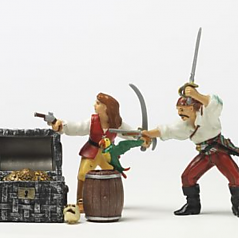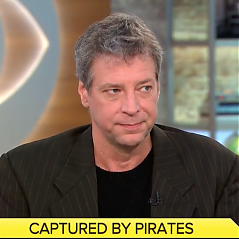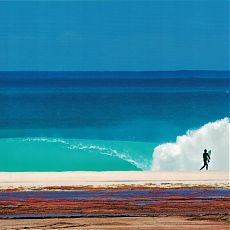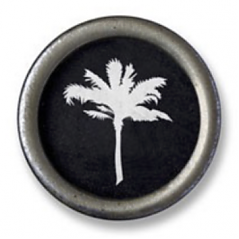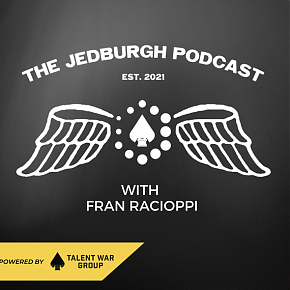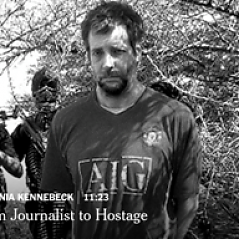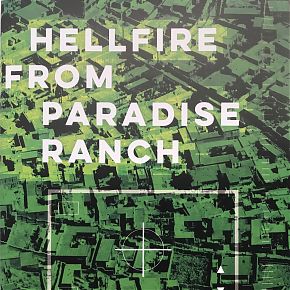Cambodian Seafarers Talk About Pirates
A fellow former hostage visits Cambodia to talk about the struggle to recover from a harrowing shared experience
May 2022
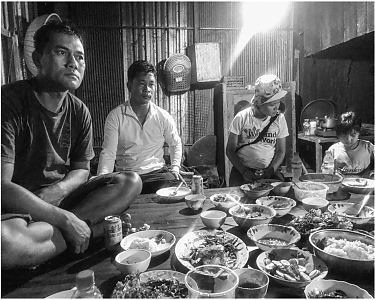
Ngem Sosan, Kim Koem Hen, and journalist Leng Len sit at a table in Cambodia
EM PHUMANNY comes from the lush province of Kampong Chhnang, north of Phnom Penh, Cambodia’s capital. He’s thirty-nine years old, a new father, and now lives on the outskirts of the city for the sake of a job in a Chinese garment factory. A decade ago, he worked on his parents’ farm, growing chilies and other vegetables. But he didn’t like the work, and he wanted to see the world. He heard that a local recruitment agency needed seafarers. “One of my aspirations was to go to sea and see other countries, and then the money they offered, a hundred and fifty dollars a month . . .” He trailed off.
“Was pretty good,” I replied.
“Yeah, is pretty good,” he answered.
I met Phumanny nine years ago, in Somalia, on a tuna vessel called the Naham 3, after Somali pirates hijacked it on the high seas and took twenty-eight of its crew members hostage. (They killed the twenty-ninth, the captain, on the spot.) I was a hostage, too. Somali gunmen had captured me on land, as a luckless journalist, and stowed me on the Naham 3 for safekeeping, probably to consolidate captives and save money. For almost six months, I lived on the ship and got to know its crew members and their stories. Most were not professional fishermen but, like Phumanny, were former farmers and laborers from the countrysides of Cambodia, China, Vietnam, the Philippines, Taiwan, and Indonesia.
I spoke no Khmer, so we communicated in a simple ship’s pidgin of English and Chinese. Life on the ship was tedious, crowded, and sometimes tense, but as long as the generator functioned it was a huge improvement over life on land. On the ocean there were no flies or mosquitoes, for one thing. I became friends with Phumanny and three other Cambodian seafarers over time, as well as the rest of the kidnapped men. Friendship in captivity can be intense, and after I was moved ashore in the fall of 2012, to be held in solitary confinement, I missed them. I was released in 2014 after two years and eight months as a hostage.
The crew of the Naham 3 would be held for nearly five years—just shy of a record for hostages taken by modern pirates. In 2013, the Naham 3 sank, and they were moved ashore, where their lives grew far more wretched. In the barren Somali bush they were underfed, sun-scorched, and thirsty. By the spring of 2014, two had died of illness. The owners of the Naham 3 had tried to pursue ransom negotiations, reportedly failed to reach a deal, and gave up. Starting in 2013, the London international-law firm Holman Fenwick Willan and a Nairobi-based humanitarian group, the Hostage Support Program, donated their time to negotiate and raise money to ransom the crew. (I helped with a small donation.)
In October, 2016, the twenty-six surviving Naham 3 crew members were freed, and I flew to Nairobi to see them. They were frail, exhausted, and eager to be reunited with their families. I sensed that there was more to their individual stories than I could learn in those few days. During our time in captivity, I gathered that some of them had wound up on the Naham 3 as a result of labor trafficking. After they returned home, I continued to think of them and started to wonder how these men from different backgrounds—Buddhist, Confucian, Christian, Muslim—contended with trauma from a near-historic term of captivity in Somalia.
So late last year I flew to Cambodia. I met Phumanny again, along with two other seafarers from the Naham 3, Ngem Sosan and Kim Koem Hen. When I first met the three men in 2012, they were fresh hostages, captive for only three weeks. Phumanny had a young, infectious smile; his lean muscles and bowl haircut made him look like a teen-ager. Koem Hen was the strongman on the Naham 3, squat and muscular and close-mouthed, what a Westerner would call stoic, though Cambodians, I learned, had their own language of survival.
Today, Koem Hen and Sosan live next door to each other in Kampong Chhnang, a mostly rural province about fifty miles north of Phnom Penh. Their wives are sisters. For a week, I visited them in their homes on the edge of National Road 5, one of Cambodia’s main highways. Koem Hen has a traditional stilted house, with a shaded space for cooking and eating under an upstairs complex of wooden rooms. We sat downstairs and shared meals at a large table while the families’ children played in the yard. I had looked forward to speaking with Phumanny in particular because of his knowledge of Buddhism. Before he became a seafarer, he had spent three years in a monastery next to the great inland lake known as Tonle Sap, and whenever he took a shower on the Naham 3 we saw a tattoo across his back, a stylized image of Angkor Wat, the Hindu-Buddhist temple in northern Cambodia. I thought he’d be full of ideas and wisdom. But he said that, because of the demands of work and raising a child, he no longer had time to meditate.
His answer surprised me because, of all the men on the tuna vessel, Phumanny seemed best equipped to survive with his spiritual beliefs intact. Now he seemed less cheerful, overwhelmed by domestic life, and frustrated with the paltry compensation he’d received from the owners of the Naham 3. After a year and a half at sea as fishermen, and nearly five in captivity, the Cambodians had been paid a total of thirty-seven hundred dollars each. Phumanny thought the company owed him at least ten thousand dollars in back wages. Thirty-seven hundred dollars was more like a grudging acceptance that the men worked at all. “They assume that that was a big amount already because of the fact that I’m poor, I’m a farmer,” Phumanny said. “But they underestimate how much labor, sacrifice, and loss I’ve invested.”
I didn’t realize the depth of the malfeasance until they explained it to me in detail. Phumanny and the other Cambodians were caught in a complex scam involving a Taiwanese-owned recruitment firm called Giant Ocean. In 2013, while the Naham 3’s crew was still in captivity, the firm’s general manager, Lin Li-chen, was arrested in Cambodia and subsequently sentenced to ten years in prison for hiring as many as a thousand Cambodians to work in slave-like conditions on fishing boats in waters off Africa, the South Pacific, and Southeast Asia. (The company has since shut down.)
The three men told me that before they went to sea, in 2010, they were hired by a now-defunct recruiting firm whose name they recalled either as Giant or Long An International. It appeared to be a professional operation. “The company that recruited us organized all our legal documents,” Phumanny said, referring to their passports and visas. “We heard through the company that we were not illegal.”
When he returned to Cambodia from captivity, in 2016, he was surprised when government officials initially accused him of breaking the law. Something was wrong with his passport, they told him, and a Cambodian immigration official confiscated it. “They asked me questions for a while, and then they asked for my passport,” he said, adding that he felt betrayed because he’d worked hard to keep his documents from being stolen through his time in captivity. “I was trying to keep it out of reach of the pirates—to try to secure all the documents I got in life. But the officer took it.”
It was Giant Ocean, in fact, that had broken the law, by recruiting the men through front agencies and then shipping them to Mauritius. Cambodian human-rights groups think that the local recruitment firm may have spirited the seafarers out of Cambodia with counterfeit passports. Moeun Tola, who heads a Phnom Penh-based N.G.O. called the Center for Alliance of Labor and Human Rights, or central, said these forged passports tend to be high-quality fakes. “Some brokers facilitate a fake passport,” he said. “We do not have the capacity to determine whether the men’s passports were real or fake.”
Tola added that Cambodia’s Ministry of Labor “abused its power” by granting a series of licenses around 2010 to recruiting agents who shipped workers to nations, like Mauritius, with no labor agreements to protect Cambodian fishermen. “In one of [these] cases, the Giant Ocean company got a license from the Ministry of Labor,” Tola said. “They placed the people on the fishing boats without wage payments, without proper health care—just put the people into the slave world.”
What angered the men most was that Giant Ocean and its subcontractors—which included Step Up Marine Enterprises, in Singapore—never paid them in full for the work they performed on the Naham 3 and other ships. (Step Up did not respond to a request for comment.) While Sosan was at sea, his wife, Sopheap, regularly took a bus to Phnom Penh to pick up a percentage of Sosan’s pay. Giant Ocean short-changed her on every visit, she said. After nine months—three payment cycles—the firm stopped paying. “On the date I was supposed to withdraw the money,” Sopheap recalled, “I went to the bank and they told me there is no money transferred to my account yet.” When she called the number for Long An, there was no answer. When she tried to visit its offices, they were shuttered. “I asked people and they said that the office had been closed for almost half a month. There was no information about where they went.”
§
WHEN I ASKED about the aftereffects of Somalia, the conversation shifted from money and exploitation to emotion and trauma. The three men described short-term memory lapses and anger, which they regarded as side effects of captivity. A common Khmer word for trauma is baksbat, or broken courage. It’s often used in connection with the long shadow of the Cambodian civil war and the atrocities of the Khmer Rouge. “In Cambodia,” Leng Len, my translator, explained, “we have this kind of a proverb: Anger makes a wrong, anger is ruin, anger is waste.”
Koem Hen talked about flying into a rage in his home province after strangers asked him not to fish. They complained about his hooks and tackle in the water. “I was very hot-tempered,” he said. He didn’t like being told what to do. But the depth of his anger surprised him. “In Somalia, I made a vow to the spirit, my guardian angel, that if I got released, I would shave my head. . . . So I shaved my head.” Shaving his head, he told me, was a way to honor local animist beliefs in natural spirits, or neak ta, which still pervade the Cambodian countryside eight centuries after Buddhism became a state religion. He hoped the gesture would calm his nerves, but it didn’t.
The second time he lost his temper—in an argument with his sister over some unwashed dishes, in 2017—Koem Hen borrowed money from his mother and drove off on his moped. He visited Sosan, his former fellow-hostage, settled in Kampong Chhnang, and later married the sister of Sosan’s wife. “I didn’t have any other place to live,” he said. Koem Hen now works for a Japanese construction firm, building and fixing local roads. But he still grows impatient with his wife. He gave a sad smile. “I am completely different from before.” He also has a four-year-old daughter and said that the sight of her can ease the exhaustion and tension he feels at work. “I feel better when I see my child,” he said. “I feel stronger and recover from the tiredness.”
When the rest of us talked about the lingering effects of captivity, Sosan didn’t say much about his own emotional state. But, one evening, he put on a recording of Cambodian percussion—a pleasant, meditative, melancholy sound of gongs and drums typically played during worship. To me, it sounded like rain. Len, my interpreter, said Sosan may have been working through some feelings by playing it on his sound system. “It’s a kind of escape,” she said.
She added that working-class Cambodian men have few emotional outlets besides getting together, as we did, for meals, or for beer and palm wine (which we drank afterward). Music and sports are the other obvious forms of release, and of course any young man can join a monastery. In the wake of Somalia, though, none of my friends had embraced religion or therapy. Western psychologists practicing in the capital are too costly for working-class people. All three of my Cambodian friends said the most restorative thing they’d found was hard physical labor. “But in Cambodia it’s like this,” Phumanny said, “if you don’t have connections, with a businessperson or a hiring person or relative, they don’t care about you. They abandon you.”
§
A FEW DAYS LATER, I visited Phumanny at his home. He lives in a garment-factory complex along a dusty, industrial stretch of highway southwest of Phnom Penh. His one-room apartment consists of concrete walls with breeze-block ventilation and a corrugated-metal roof. It is set in a row of similar units that are all painted white; they reminded me of the grim tenement buildings in “A Clockwork Orange.” After their shifts, workers socialized outside, where it was cooler. Phumanny set thin mats on the ground for us to sit. As mopeds rumbled down nearby streets, neighbors set up speakers for post-work karaoke. Phumanny’s wife asked me for some money to buy food for dinner, borrowed a hot plate and a rice pot from a neighbor, and then cooked a beautifully spiced rice-and-chicken meal for us.
Phumanny said he didn’t hold a grudge against the pirates—as a Buddhist, he said, he “tried to understand their intention”—but he did hold a grudge against the owners of the Naham 3 and the people who’d recruited him, for paying out far less than he felt he deserved. Caritas Cambodia, a Catholic N.G.O., helped resettle the men when they returned home. The group worked with a seafarers’ charity called iswan to build a new concrete-walled house for Sosan’s wife and daughter. Father Bruno Cosme, a priest with experience in seafarers’ issues, negotiated the thirty-seven-hundred-dollar payments that each man received from the ship’s owners. Father Bruno acknowledged the low sum but said “there was no previous agreement of any kind that said the time in captivity should be paid.” Phumanny felt betrayed, for obvious reasons, and he’d thought about the problem in more detail than the others. It seemed to be his cause, even if he’d met a dead end. Koem Hen and Sosan wanted more money, too, but they seemed to have moved on.
I wondered whether Phumanny might find more lucrative work and be in a better position if he trained for a year to become a moped mechanic. But Phumanny resisted the idea; he had a kid to raise. He didn’t want the stress of switching careers. And Giant Ocean, or the shipowners, or the subcontractor Step Up—whoever in this complicated saga had managed to pilfer his pay—owed him more.
There was a fourth Cambodian, Korn Vanthy, who had been a bit of an oddball on the Naham 3, less integrated than the others. A skilled fisherman, he reminded me of the Mad magazine mascot, Alfred E. Neuman, with ears that stuck out. Every morning, I would find him on the deck at dawn beside three or four long, silvery-dark king mackerel, caught on an improvised hand line that we used to ease the boredom of captivity and supplement our food from the ship’s kitchen. After he returned home to Cambodia, he disappeared. I never saw him during my trip, and his friends said he had stopped answering his phone.
§
NEAR THE END of my week in Kampong Chhnang, Koem Hen and Sosan and their families took me to a local temple to celebrate the Water Festival, a Cambodian holiday marking the end of the rice harvest and the annual reversal of the current along the Tonle Sap river, which feeds Cambodia’s long central lake. The scene was reminiscent of an American county fair. There were nighttime games and food, wrestling, klieg lights, and the sound of monks praying through a P.A. system—a loud chant from inside the pagoda walls. The pagoda had high columns, flaring gables, and a fine layer of paint that looked like (but wasn’t) gold leaf.
Sosan’s eighteen-year-old daughter warned us that local gang members might want to start a fight. We wandered to the pagoda’s main terrace and watched little kids shriek and run, chased by great lumbering puppets—a red devil, a white-faced woman—while monks in saffron robes ran beside them, filming the parade with their phones. Drums and bells pounded. After the puppets disappeared, a crowd of people chanting in rhythm to the drums and clapping emerged; fireworks crackled and flared. Townspeople holding artificial trees with paper money as foliage—actual Cambodian riel—paraded past us, celebrating the donations made by the town to maintain the pagoda. Yellow parasols glowed and fluttered in the breeze.
A formless excitement—over nothing but the urge to celebrate—seemed to run through the crowd. The bells and drums created a wonderful clamor. Octavio Paz’s description of the fiesta in Mexico, as a form of collective release, came to mind. Minutes later, without warning, it rained—first in thick drops and then in warm, black, glittering sheets. We ran for cover and stood, drenched, with dozens of strangers. At the end of a beer-soaked week of reminiscence about captivity, a sense of rapture took hold and lifted away the lingering heaviness. It wasn’t a permanent solution to any of our problems, and it had no odor of pious religion, or meditation, or whatever I expected to learn from Phumanny. It was just many things at once, a rough but ancient reminder that there can be many routes out of sorrow.
Michael Scott Moore
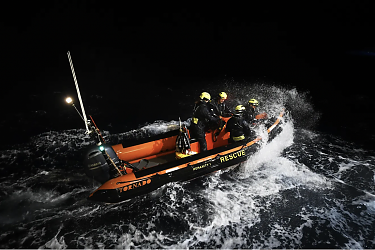
Rafts of the Medusa
Why every day on the Mediterranean is a new scandal for Europe. For both Foreign Policy and Die Zeit.
California’s Attempt at Land Reparations
How land seized from a Black family 100 years ago may be returned. The Bruce’s Beach story from a hometown angle, for The New Yorker
Day of the Oprichnik, 16 Years Later
The novelist Sorokin, the president Putin, his man Dugin, and the war in Ukraine. For n + 1.

The Rushdie Narrative
Knife and the crumbling ground beneath free speech
There Must Be Some Way Out of Here
An essay on Bob Dylan, “All Along the Watchtower,” and Somali pirate captivity.
That Mystic Shit
The life of Lou Reed in two biographies

Cambodian Seafarers Talk About Pirates
Mike visits Cambodia for The New Yorker to talk about a harrowing shared experience in Somalia
The Muslim Burial
Cambodian hostages remember digging a grave for one of their own. A sequel chapter to The Desert and the Sea
The Real Pirates of the Caribbean
Adventure journalism in Southern California. A travel essay for The Paris Review.

Antifa Dust
An essay on anti-fascism in Europe and the U.S., for the Los Angeles Review of Books
Was Hitler a Man of the Left?
A book that helped Republicans in America lose their damn minds.
Ghosts of Dresden
The Allied firebombing of Dresden in 1945 destroyed the baroque center of what Pfc. Kurt Vonnegut called, in a letter home from Germany, “possibly the world’s most beautiful city.”

George Freeth, Biographed
The first academic treatment of America’s surf pioneer. Also, was Freeth gay?
It’s Called Soccer
Americans live on what amounts to an enormous island, defended on two shores by the sea, and we’ve evolved a few marsupial traditions that nobody else understands.
Tilting at Turbines (in the Severn River)
The morning was clear and cold, with frost on the church steeple and the cemetery grass. I had a quick English breakfast at a white-cloth table, in my wetsuit, and drove to Newnham, a village on the Severn River in Gloucestershire, parking near the White Hart Inn.

The Curse of El Rojo
I’d packed the car lightly — a bag of clothes, a bag of cassette tapes, a backpack of books, a few essential tools.













